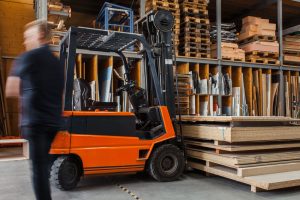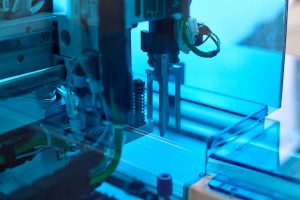5 Ways to Boost Profitability with Industrial Automation Recruitment [2023]
The fourth industrial revolution has provided many new ways of accomplishing previously labour-intensive tasks. Find out how Industrial Automation can help your business.
The incredible development speed of technologies like artificial intelligence, Big Data, 5G, and the Internet of Things are steadily converging to create a new industrial landscape. Known widely as the Fourth Industrial Revolution, or the more technical-sounding ‘Industry 4.0’, this landscape will be characterised by digital automation systems that improve the intelligence, accuracy, and cost-effectiveness of our current industrial production lines. But this new industrial automation doesn’t begin and end on the factory floor; experts such as John Soldatos predict that software suites like ERPs (Enterprise Resource Planners), CMMs (Computer Maintenance Managers), and even CRMs (Customer Relationship Managers) will all eventually interconnect to share and process data in one long tunnel (p. 9 2019). From the shopfloor to the factory floor, data will be exchanged fast and freely.
While this all might sound great, you may still be wondering how it is that Industrial Automation can decrease costs while increasing intelligence and accuracy. In this article, we’ll explain the precise ways that Industrial Automation can achieve this, and how they specifically relate to profitability.
1. Increase dynamic efficiency through flexible IT configurations
A common term in economics, ‘dynamic efficiency’ refers to the speed at which a firm or economy can adjust its production (either from one good to another, or from one amount of output to a smaller or larger degree). At present, most manufacturers need to change the physical settings on an OT (operational technology) system in order to adjust the configuration of a production line. With the advent of new information technology (IT) integrations, production lines should become more easily customisable at a mass scale. By quickly adapting to the needs of the market, businesses can become more efficient, thus competitive, and finally, more profitable.
2. Predictively maintain and improve industrial machinery
Reactive maintenance of machinery is inefficient for obvious reasons. When a machine on a production line breaks down, the entire line is affected, delaying products and losing potential customers. Further, the cost of repairing the damage can be massive, and rely upon third parties to create or deliver replacement parts. With proactive maintenance no such delay in production will occur, because the machines will have been repaired before breaking, or the replacement parts/machines will already have arrived before the old one has worn out. This is achieved by collecting and analysing data derived from the machinery, including vibration, sounds, thermal imaging, and of course, enterprise management software. With lower maintenance costs and fewer breakdowns, profitability rises.
3. Quality control, and the path to Zero Defect Manufacturing (ZDM)
Similar to proactive maintenance, better quality control is an outcome of better data collection and management, as enabled by Industry 4.0. Between this and the ability of cyber-physical systems to self-learn from mistakes, product defects become predictable, and therefore solvable. As a given production line commits more mistakes, both the machines and their digital operators will learn how to prevent those outcomes from reoccurring, which makes the ideal scenario of Zero Defect Manufacturing more achievable than before. With less defects and higher quality products, businesses can sell more products, thus increasing profitability.
4. Symmetrical information across the supply chain
One of the main causes of supply chain inefficiency is asymmetric information; one or more agents in the supply chain are at an information disadvantage to others, whether that be due to human error, information siloing, or external factors. By digitalising information about the physical part of the production line (status of machines, processes, orders, etc), information is spread quickly and accurately from the production line to the supply chain and logistics department. Less manual communication between humans, and more automated communications from machines to humans. This decreases errors and costs while increasing efficiency, hence boosting profitability.
5. More dangerous work for machines, less dangerous work for humans
According to Safe Work Australia, there were 14,014 serious claims made by Manufacturing workers based on work-related injury and disease (the second-highest number of claims in any industry by a slim 0.5% margin) while there were 19 fatalities, the fourth-highest of any industry. With robots replacing humans on the production floor, the risk of injury or death is greatly reduced. Further, technologies such as Virtual and Augmented Reality have shown promise in training workers to operate safely on machinery that still calls for human control. Wearables such as smart watches also play a part in this equation, allowing employees’ health to be monitored while at work.
Concluding thoughts
Whether or not all of the technologies underpinning industrial automation come to fruition, there’s no doubt that the fourth industrial revolution is going to change the way that we work in the next few years, and that industrial automation will play a pivotal role in that transition.
There’s never been a better time to have a hand in managing automated processes and new technologies in Australia’s industrial automation industry. New World Consulting are proud to play our part in this industry, and seek to connect talented, enthusiastic workers with great businesses.
References
- Industrial Automation in the Industry 4.0 Era: Performance Analysis and Applications, edited by John Soldatos, et al., River Publishers, 2019. ProQuest Ebook Central, http://ebookcentral.proquest.com/lib/unimelb/detail.action?docID=5770807
- Key work health and safety statistics, Australia 2021, Safe Work Australia, accessed 28/10/22
New World Consulting connect great talent with excellent companies in industrial automation recruitment
You can find out more about our candidate services here and our client services here.
Read from our blog
News and industry insights into industrial automation




